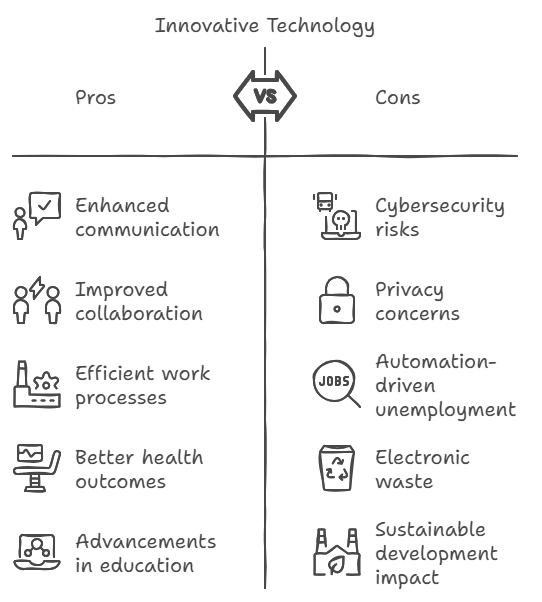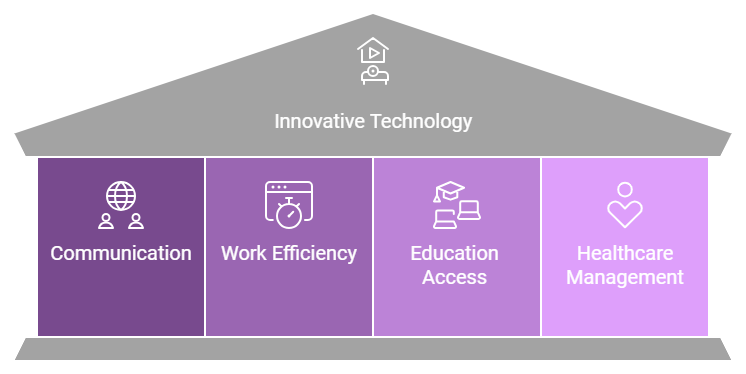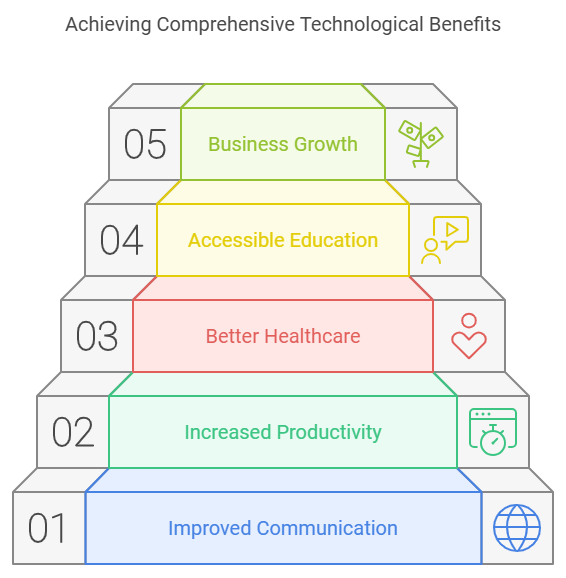Top 5 Advantages and Disadvantages of Smart Technology
Published: 12 Dec 2024
Table of Contents
Overview:-
Top 5 Advantages and Disadvantages of Smart Technology In the modern world, technology Patterns how we work, communicate, learn, and solve problems. While its innovations are simple and easy to use, they also create unique challenges.
Here’s a complete analysis of the Top 5 Advantages and Disadvantages of Smart Technology.
- Innovative technology has transformed many aspects of our daily lives, making tasks easier and creating new opportunities. It enhances communication, fosters more substantial relationships, improves collaboration, and advances healthcare and education.
- While these breakthroughs offer tremendous opportunities, they also introduce new obstacles, including digital transformation challenges and cyber security risks.
- These include privacy concerns, risks associated with automation-driven unemployment, electronic waste disposal, and the broader impact on sustainable development.
- This article examines technology’s positive and negative aspects, helping us understand its effects and how to make the most of them.
Advantages:

1. Improved Communication
2. Increased Productivity
3. Better Healthcare
4. Accessible Education
5. Business Growth
Disadvantages:
1. Privacy and cybersecurity risks.
2. Job loss due to automation.
3. E-waste and environmental concerns.
4. Challenges in adapting to digital transformation.
Modern World Innovative Technology
The Role of Innovative Technology in Modern Life:-
Innovative technology plays a crucial role in contemporary life by making tasks faster, easier, and more connected. It’s present in almost everything we do, from communication to work and health, impacting nearly every aspect of our lives.
Example: – mobile phones and the internet allow us to stay connected in small villages, while AI and automation make tasks more efficient and productive. We can shop online, access education from anywhere, and even receive healthcare advice from our homes

Advantages of Technology

1. Improved Communication
2. Increased Productivity
3. Better Healthcare
4. Accessible Education
5. Business Growth
Advantages of Technology:-
- Improved Communication
Technology has revolutionized the way we communicate. From instant messaging apps to video calls, technology connects us with people worldwide in real time. This has made personal and professional communication faster, easier, and more efficient. For example, Microsoft Teams and Google Meet enable businesses to conduct virtual meetings effortlessly, eliminating the constraints of geographical distances. - Increased Productivity
With the help of innovative tools and software, tasks that once took hours can now be completed in minutes. Automated processes, cloud computing, and project management tools like Trello or Asana help employees stay organized and manage their workload effectively. This has boosted productivity across industries, allowing businesses to achieve more in less time. - Better Healthcare
Technology has transformed the healthcare industry in remarkable ways. Telemedicine allows doctors to consult with patients remotely, while advanced medical equipment aids in accurate diagnoses. For instance, robotic surgeries offer precision and reduce recovery times. Technology has made healthcare more accessible and efficient, saving lives and improving patient outcomes. - Accessible Education
Education has become more accessible than ever due to innovative technologies. Online learning platforms like Coursera and Khan Academy allow students to learn from anywhere. Technology has bridged the gap, offering equal opportunities for individuals to gain knowledge and improve their skills. - Business Growth
Technology drives business growth by providing tools to streamline operations, improve customer engagement, and access new markets. E-commerce platforms like Shopify and social media marketing have empowered small businesses to reach a global audience. Using data analytics, companies can gain valuable insights, helping them make smarter decisions and drive profitability.
Disadvantages of Technology:-

1. Cybersecurity Risks
2 . Privacy Concerns
3. Automation-Driven Unemployment
4. Electronic Waste
5. Sustainable Development Impact
1. Cybersecurity Risks
As technology advances, so do cyber threats. Hackers and malicious software pose a constant risk to individuals and businesses. Cyberattacks can lead to data breaches, financial losses, and identity theft. Companies need to implement strong security measures to protect sensitive information.
2. Privacy Concerns
Privacy has become a significant concern with the increase in digital data sharing. Personal information is often collected without individuals’ consent or awareness. Social media platforms, apps, and websites track user activities, raising questions about how our data is used and stored.
3. Automation-Driven Unemployment
While automation improves efficiency, it also leads to job displacement. Machines and artificial intelligence are replacing human workers in various industries. For example, self-checkout machines in supermarkets and automated factories reduce the need for cashiers and assembly line workers, potentially causing unemployment.
4. Electronic Waste
As we upgrade our devices, old electronics end up as waste. Electronic waste, or e-waste, is a growing environmental issue, as these products contain harmful materials like lead and mercury. Improper E-waste disposal can pollute the environment and pose health risks to communities.
5. Sustainable Development Impact
Innovative technologies, though beneficial in many ways, can harm the environment. Manufacturing devices, mining for materials, and running data centers require significant resources and energy. This raises concerns about the long-term sustainability of technology and its impact on the planet.
Conclusion:-
- Innovative technology has dramatically improved:
- Communication: Faster and more efficient connections worldwide.
- Productivity: Streamlined workflows and processes.
- Healthcare: Better diagnosis, treatment, and access.
- Education: Learning opportunities made widely accessible.
- Business Growth: Enhanced decision-making and global reach.
- However, challenges must be addressed, including:
- Cyber security Risks: Protecting sensitive data from breaches.
- Privacy Concerns: Ensuring responsible data use and storage.
- Environmental Impacts: Managing electronic waste and resource depletion.
- Looking Ahead:
- As technology advances, balancing its benefits with potential drawbacks is vital.
- A sustainable and secure approach is essential for a prosperous future.
*.* Most Frequently Asked Questions *.*
1. How has technology improved communication?
Technology has made communication faster and more convenient through instant messaging, video calls, and social media, enabling people to connect in real-time.
2. What are the disadvantages of technology in the workplace?
Some disadvantages include cyber security risks, automation-driven unemployment, and the potential loss of personal privacy due to constant data sharing.
3. Can technology help improve healthcare?
Technology has revolutionized healthcare by making it more accessible through telemedicine and improving treatment accuracy with advanced medical equipment like robotic surgery tools.
4. What is the impact of technology on education?
Technology has made education more accessible, with platforms like Coursera and Khan Academy providing online courses and learning materials that can be accessed anywhere in the world.
5. How does technology affect the environment?
While technology offers many benefits, it also contributes to e-waste and resource depletion, which can harm the environment if not managed properly.
-: Thank you for reading:-





